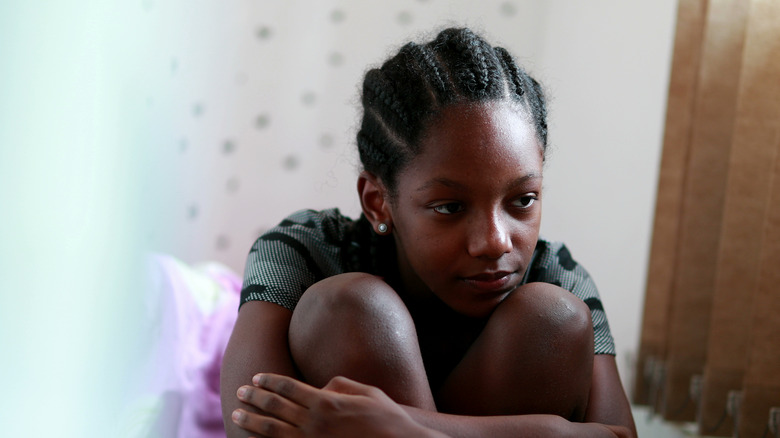Why ADHD Goes Undiagnosed In So Many Women
ADHD is more common than you may think. According to the Centers for Disease Control and Prevention, six million U.S. children were diagnosed with the disorder from 2016 to 2019. However, this number is extremely disproportionate. Data shows that in comparison to 13% of boys being diagnosed with ADHD, only 6% of girls were diagnosed with ADHD in these three years — less than half. This bias continues into adulthood, with 5.4% of men receiving an ADHD diagnosis compared to 3.4% of women (via ADDitude).
Though you may put this difference down to ADHD simply being more common in men, the truth is that many women who have ADHD never get diagnosed with the disorder. This is due to several reasons, including varying symptoms, personality bias, and many women being diagnosed with the incorrect disorder when they do seek help, even if they display ADHD symptoms.
Whether you want to support a friend with ADHD or are interested in learning why so many women remain ADHD-undiagnosed, here's all the information about why a large number of women with ADHD remain undiagnosed.
Part of the under-diagnosis stems from a misunderstanding of how girls behave
A huge factor in why ADHD goes undiagnosed in women more often than in men is the difference in symptoms. Per Psychology Today, women with ADHD express ADHD symptoms differently than their male counterparts. In a school setting, boys with ADHD are usually hyperactive and overall more noticeably distracted, whereas girls will fit in a classroom but may face difficulties when it comes to social conversations with their peers.
Moreover, a lot of the symptoms that girls and women do display of ADHD are often attributed to personality rather than ADHD (via BBC). As consultant psychiatrist and ADHD researcher, Helen Reed states, "[W]e expect girls to be more sociable than boys anyway," meaning that a lot of the hyperactivity or missed social cues that come with ADHD are overlooked for typical female traits. This is especially true when it comes to comparing girls to boys of the same age, which in turn, can lead to girls and women going through their school education and later years completely undiagnosed.
ADHD can cause other disorders to occur if left undiagnosed
Though most people with ADHD will have some sort of issue with inattentiveness, women are more likely to experience a secondary disorder on top of their ADHD (via Psychology Today). The top two most common of these are anxiety disorders and depression disorders. This anxiety and depression could be even more noticeable for women with undiagnosed ADHD, as living without a diagnosis can make life tricky to navigate. In general, mood swings and mood issues could be said to have been brought about by lack of regulation in the life of a woman with undiagnosed ADHD, especially when anxiety and depression are factored in.
Plus, girls who have combined ADHD, a mix of both hyperactivity and trouble concentrating are more likely to consider self-destructive actions (via BBC). Though there is no concrete proof to support the idea that ADHD medication will remove self-destructive thoughts completely, ADHD treatment has been shown to dramatically and positively impact ADHD-diagnosed individuals in their everyday lives. It can also lift the mental burden that those who are undiagnosed often live with.
Girls masking symptoms could be a key part of misdiagnosis around ADHD
Additionally, even if girls do suspect they have ADHD symptoms at a young age, they are much more likely to ask for assistance with their schoolwork and to reach out when they're struggling (via ADDitude). Furthermore, girls have a natural tendency to "people please" as part of their efforts to appear "normal." This willingness to try and mask ADHD symptoms could lead to a bias for boys being diagnosed with ADHD.
Development pediatrician Patricia Quinn M.D. agrees, stating, "Most people have a misperception that ADHD is a disorder of hyperactive elementary school-aged boys." This could partly be because boys are more likely to be diagnosed with ADHD from a younger age, but also because girls are more adept at masking their potential ADHD symptoms. Teachers therefore don't pick up on symptoms like hyperactivity and inattentiveness the same way they would with male students. Once again, personality plays a large role. Quinn revealed that, even when teachers pick up on the above symptoms in female students, they don't make the link to ADHD like they would when seeing the same behavior in male students.
Incorrect diagnoses are a huge part of why ADHD remains under-diagnosed in women
Another major reason ADHD remains undiagnosed in so many women is because several women often receive the wrong diagnosis when they do go to a doctor. Per Verywell Mind, women with ADHD are likely to live with sleep disorders, substance disorders, and mood disorders amongst other conditions, all of which stem from trying to gain control of their lives. Because of this, doctors and additional specialists may mistake the above disorders for the real issue instead of a byproduct of ADHD.
Psychologist Kathleen Nadeau states that girls with undiagnosed ADHD may suffer from "chronic low self-esteem, underachievement, anxiety, depression, teen pregnancy, [and] early smoking during middle school and high school" (via American Psychological Association). As adults, women with undiagnosed ADHD face difficulties such as "divorce, financial crises, single-parenting a child with ADHD, never completing college, underemployment, substance abuse, eating disorders and constant stress due to difficulty in managing the demands of daily life."
These potential side effects of undiagnosed ADHD are why it's so crucial for women who suspect they have ADHD to speak to a specialist about their symptoms and begin the journey to receiving a diagnosis.
COVID played a major part in women realizing their ADHD symptoms
On a hopeful note, research psychologist Stephen Faraone believes that COVID-19 and the lockdowns implemented because of it may have contributed to more ADHD diagnoses for women. Speaking to NBC News, Faraone stated, "Big life changes can lead women to recognize overlooked or misdiagnosed symptoms." Of course, lockdowns were a huge change for many of us, but certain groups were hit harder than others. As expressed by psychotherapist and ADHD coach Terry Matlen, women with undiagnosed ADHD struggled the most during these lockdowns.
Matlen, who also runs a women-only ADHD Facebook support group, shared that "a lot of women reaching out lately are falling apart and shutting down," and noted that more and more women seek support from her every day. As everyone was forced to stay indoors and regulate their own daily routines, women with undiagnosed ADHD could clearly see how they struggled keeping on top of routine tasks and sticking to a schedule, which then led many of them to reach out to specialists like Matlen.
The path to diagnosing more women correctly with ADHD is long, but with more information coming out yearly, the future of more ADHD diagnoses is bright.





